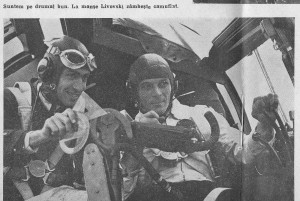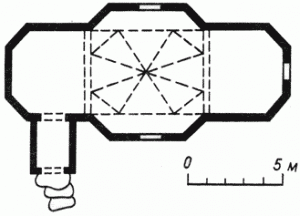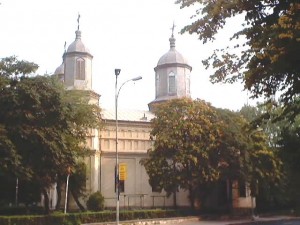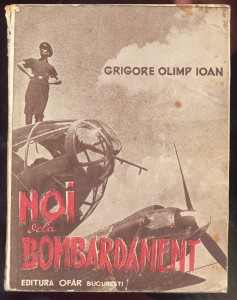Aurelian (Rică) LIVOVSCHI
Aurel Livovschi (right) in his Heinkel III nr 18
Family Background:
Born on 4 August 1902 in Tulcea, a Romanian port of the Lower Danube, the youngest child in a family of six siblings of Rev, Zenovie Livovschi, (1858-1933) and of Polixenia, nee Nicodinescu. In a direct line the Livovschi family had a long tradition of Moldavian Orthodox clerics whose name derived from the city of Lemberg (Lvov) in the Polish Galicia. By the end of the 18th century at the time of the first partition of Poland of 1772, the city of Lvov was incorporated in the Habsburg Empire. As a result of the persecution suffered by the Orthodox under pressure to convert to the Uniate faith and recognize the Pope, the family took refuge across the border in Northeastern Moldavia, an Orthodox Principality under Ottoman rule. These were uncertain times following the defeat of Napoleon and the subsequent victory of the Russians over the Ottomans in 1812. As a result of the Peace Treaty of Bucharest, a huge territory between the rivers Pruth and Dniester, in Eastern Moldavia changed hands being annexed by Russia for the next hundred years to 1916. The Russians renamed this new province “Bessarabia”. This was a fertile land of some 45,000 square kilometres – twice the size of Wales, or two thirds the size of Scotland. During the first Russian census of Bessarabia the family was assigned a surname deriving from the earlier city of origin – Lvov, and so they became known by the nickname of Lvovski to the Russians and Livovschi to the Romanians.
The Livovschi continued their vocation of clerics which represented one of the three acknowledged “estates” (social classes) in Imperial Russia, enjoying both status and privilege. In 1793 the first Livovschi settler built a wooden church in Sudarca, Northern Bessarabia, now preserved as a historic monument in the Open-Air Museum of Chisinau. The first settler was known as “Popa din Sudarca”, that is the “Vicar of Sudarca” and Reverend Zenovie Livovschi represented the fifth documented generation of Orthodox clerics descended in direct line from this vicar. Zenovie was born in 1858, after the Crimean War, the son of Rev. Theodor Livovschi of Tomai. Amongst his kinsmen who served the Russian Orthodox Church loomed large several distinguished figures. One was the composer and choir Master Gregory Lvovski (1830-1894), director of the Cathedral choir of the St Alexander Nevsky of Sankt Petersburg, whose Cherubic Hymn is sung in all Orthodox churches around the world.
http://www.youtube.com/watch?v=o0Ol_vXZdBw&feature=related
Another kinsman was Rev Dimitrie Lvovski (aka Dimitrie Riofusiki to his Japanese brethren) composer and church choir master at the Russian Orthodox Mission in Tokyo, during the second half of the 19th century. Zenovie had a brother Rev. Ilie Livovschi an Elder (egumen-staret) of the Calarasoaica (?) Monastery in County Soroca.
In 1878, at the age of twenty, Zenovie graduated, with a BA in Divinity from the Theological Seminary in Ismail, at the time of the Russian-Ottoman war of 1877-1878. As the Orthodox canons required priests to be married before they were ordained, young Zenovie married the only daughter Constantin Nicodinescu and Zinca Eiser exiles from Fagaras, in Transylvania, who fled the 1848 Revolution. Constantin was a mill mechanic on the estate of Prince Alexander Murousi in County Cahul, Southern Bessarabia. The Prince’s wife was a lady of a Pahanriot family from Constantinople. In 1860 Princess Murousi was godmother to Constantin’s daughter and she chose for her goddaughter the Greek name of Polixenia. By 1878 the newly-weds Zenovie and Polixenia had a first son by the name of Vicentiu, the eldest of six children which were to follow. Among this brood the youngest was Aurelian, 24 years younger than his brother Vicentiu. At the conclusion of the Russian-Ottoman war the Principality of Romania gained independence and was granted by the Treaty of Berlin of 1878 the province of Dobrogea which gave it access to the mouths of the Danube and the Black Sea.

 Two years on, in 1880, Rev. Zenovie Livovschi moved his young family from Russia over the border to the newly-independent Kingdom of Romania. He settled in the town of Tulcea, a port on the Lower Danube, where he soon became a respected figure as a co-founder of the Boys Secondary School (Liceul Spiru Haret) where he taught Religious Education. At the same time he served in the Diocese of the Lower Danube for over 46 years, first as Dean of the cathedral church of St. Nicholas, Tulcea (1880-1916) and after a two years interruption, due to the Bulgarian occupation during WWI, a further period as rector of the church of The Transfiguration, Schimbarea la Faţă (1918-1928) until his retirement at the age of 70. During his time in the Diocese, Rev. Zenovie gained in the hierarchy of the Church with the grades of “Econom Stavrofor” and served on the Council of the Ecclesiastical Court.
Two years on, in 1880, Rev. Zenovie Livovschi moved his young family from Russia over the border to the newly-independent Kingdom of Romania. He settled in the town of Tulcea, a port on the Lower Danube, where he soon became a respected figure as a co-founder of the Boys Secondary School (Liceul Spiru Haret) where he taught Religious Education. At the same time he served in the Diocese of the Lower Danube for over 46 years, first as Dean of the cathedral church of St. Nicholas, Tulcea (1880-1916) and after a two years interruption, due to the Bulgarian occupation during WWI, a further period as rector of the church of The Transfiguration, Schimbarea la Faţă (1918-1928) until his retirement at the age of 70. During his time in the Diocese, Rev. Zenovie gained in the hierarchy of the Church with the grades of “Econom Stavrofor” and served on the Council of the Ecclesiastical Court.
The cathedral of St. Nicholas Tulcea where rev Zenovie Livovschi was Dean for 36 years.
The Family during The Great War of 1916-1918:
The first World War left deep scars on the family, a time during which Rev. Zenovie was tortured by the Bulgarian occupation soldiers who were hoping to find a cache of gold for which purpose they burned his toes with church candles in an attempt of extracting a confession. At a time in Romania the national currency was in gold coins and banks were not existent so well-to-do people kept their gold savings at home. The old reverend who led an austere existence had no savings as all his investments went into the education of his six children, so the Bulgarians went empty handed in spite of their exertions. Zenovie’s son Octavian (1890-1916), a graduate in elctrotechnical engineering from Iasi University and a Captain of the 72nd Infantry Regiment (Mizil) died in September 1916 at the battle of Caineni Pass, in the Carpathians. Another son, Virgiliu (1885-1928), a student in mechanical Engineering from the University of Grenoble returned from the front line severely shell-shocked, a condition for which he was treated at the infamous Costiujeni hospital, in County Chisinau, where he died. Zenovie’s eldest son, Vicentiu was a graduate from the faculty of Pharmacy in Buchartest and during WWI was cited in dispatches several times and received from H.M. King Ferdinand the Military Order of the Grand Cross of Romania for having successfully organized the evacuation of a military hospital from Brasov with over 1,000 wounded soldiers in the wake of the German advance. In 1916 Captain Vicentiu Livovschi comandeered a train convoy to evacuate the wounded to safety in what was left of the free territory of Romania iin Couty Iasi. During the Great War Vicentiu was also head of the Chemical Warfare School (Scoala Militara de Gaze) and a liaison officer with the Tsar’s Allied Command before the Russian armies mutinied to foment the Bolshevic Revolution. For his services Tsar Nicholas II bestowed on him the military Order of St. Stanislas.
All the eldest five of the Livovschi children followed a higher education to become professionals and all four sons served with distinction in the First World War, which brings us to the youngest – Pilot Aurelian “Rica” Livovschi.
Early Education:
In 1909 to 1916 Aurelian enrolled as pupil of the Spiru Haret Lycée in Tulcea where his father taught Religious Education and his elder brother Virgiliu, seventeen years his senior taught Physics and Chemistry. However, unlike his much older brothers and sisters who graduated either in Pharmacy, Medicine or Engineering, Aurelian was not academically inclined being instead keen on sports where he excelled in swimming, skating and hockey. In 1916 his education was interrupted by the occupation of the Bulgarian armies. During this time we find him with his parents in the relative safety of the Danube Delta, at Chilia Veche. Here the fourteen-years old Aurelian enrolls as a boy scout on a warship of the Romanian Royal Navy. This momentous period shaped his future career as he achieved the unusual distinction of skating in record time on the frozen Danube over a distance of 72 kilometres between the ports of Tulcea and Sulina: to this end he usesdan umbrella as a prop instead of sails, to increase his performance. Once the war was over Aurelian reintegrated the Lycée but was compelled in 1919 to re-sit his finals which he passed (just) at another school – the Voyevode Mihai Lycée of Cahul, in Southern Bessarabia.
Aviation Career:
Aurelian’s brothers feats of arms during the Great War caused him to do his bit for his country and so he enrolled in the Aviation School of Tecuci where he qualified as a pilot, aged 22 (Livret de Serviciu Militar 1924, matricola 128 CR). Here, at Tecuci, in October 1925, he further trained to become one of the first Romanian Military parachutists. He was drafted for national military service, which he completed in 1926 with the grade of “plutonier aviator”, at the 3rd Aviation Corps (Galati) commanded by squadron leader Capitain Alexandru Cernescu. Unfortunately he failed the medical test for which he retired from active service to pursue between 1926 to 1939 a civil career in Bucharest as office clerk. In spite of this disappointment during all this period the passion for flying remained very much alive as he joined an elite group, the “League of Romanian Airmen” – “Liga Piloţilor Români” (membership card nr 21 dated 24 July 1936). On 30th March 1939 he wishesd again to enroll as an active military pilot, but failed again the medical test (“neconcentrabil”). Two weeks later, so his eldest brother pharmacist Colonel (Reserve) Vicentiu Livovschi found him a place at the “Scoala de Piloţi de Război” (School of Fighter Pilots) of Buzau where on la 17th March 1939, Aurelian enrolled at a refresher course , graduating as “adjudant pilot” on 20th June 1939. The following 17th September 1939 he was drafted as an active fighter pilot in the “Flotila 3 de Aviaţie” (Third Aviation Corps), and on 1st March 1940 attends the School for Twin-Engine Aircraft “Şcoala de Bimotoare”. On 1st Iuly 1940 he is drafted as a fighter pilot on Heinkel 111 aircaft and in July 1941 he is a member of the “Flotila 1 Bombardiere “(First Corps of Bomber Aircraft).
Over a period from July 1940 to September 1941 Livovschi is entrusted with 31 missions on the Eastern front. His last mission, on 21st September 1941 is the Odesa srailway station targeted by a formation of nine Heinkel aircraft He-111H3. His twin-engine Heinkel nr. 17 (he usually flies nr 18) gets a direct hit from the anti-aircraft artillery in Odessa and Livovschi’s plane plunges in Lake Ialpug in Southern Bessarabia. There are no survivors from the crew of five airmen (Esc 78/Gr.5 Bomb) formed of the following: adj.stag.r.pil. Aurel Livovski (sic)+ adj.sef.obs. Florea Truică+ smstr. Petre Dăbuleanu+ serg.mitr. Nic. Avramescu+ cap.mitr. Petre Iliescu.
V. Niţu (personal communication, Sep. 2002) makes the following remarks:
“So he was part of the 5th Corps, an elite unit of the Romanian war aviation. I recall from my visit to Air Commander Dan Stoian some of the photos he had shown me which were intended for his forthcoming book. Amongst these there was one particular picture showing a He-111 airplane being rescued from a lake. It may have been very likely this very aircraft. There was also a rather gruesome picture of an airman decapitated as the aircraft was hit.”
Livovschi’s remains were first buried in the nearby village of Vlădiceni, County Ismail and subsequently reburied by his brother Col. (Res) Vicenţiu Livovschi in the village of Cuza Vodă, County Cahul where their father and grandfather respectively served as Orthodox parish priests.
On 4th November 1941 Aurelian Livoschi, a member of the din Romanian Royal Airforce (Aeronautica Regală Română – Esc.78/Gr. 5 bomb.) who died in action aged 39 39 receives by Royal decree of H.M. King Mihai I, the Gold Cross of the “Virtutea Aeronautică de Război cu spade” (Brevet nr 387 IDN Nr 3037), “for having completed, in very difficult conditions, 31 missions”.
Aurelian (Rică) Livovschi is mentioned in the Memoirs of Grigore Olimp Ioan, sub titlul published by the OFAR publishing house, Bucharest under the title “Noi dela Bombardament” (vezi fattached photo, as a pilot of his Heinkel aircraft).
Likewise, his former colleague Capt. Ion Profir recalls Livovschi in his Memoirs:
“Pilot Livovschi had a raven called Antonică which was constantly perched either on his aircraft (The Heinkel He-111 nr 18) or sometimes in front of his tent which was pitched nearby the airstrip. After his master failed to return from his fateful mission Antonică also disappeared.”
Sixty years after the end of WWII the memory of Romanian airmen who fought to preserve the territorial integrity of their country is yet to be honoured in a manner which is done by all civilized European nations.
NOTE: for the biography in Romanian visit:
http://www.aviatori.ro/dict_pers.php?sel=L






No Comments so far ↓
Like gas stations in rural Texas after 10 pm, comments are closed.